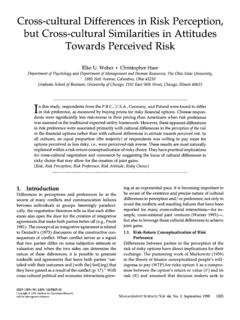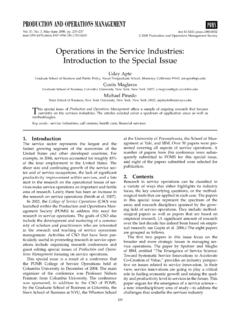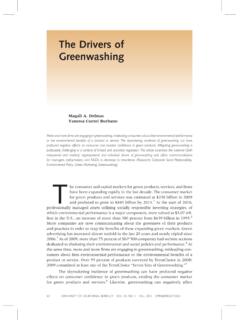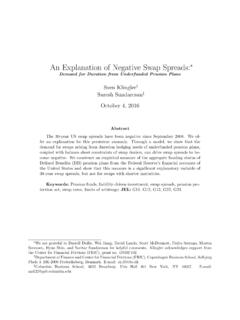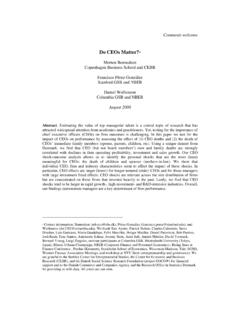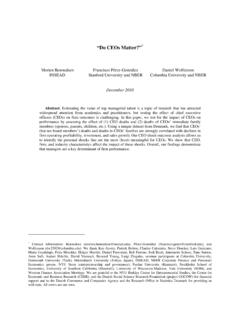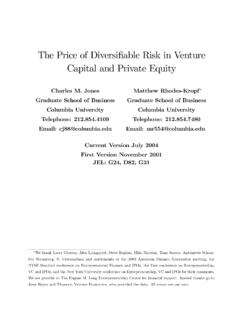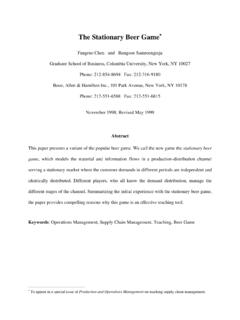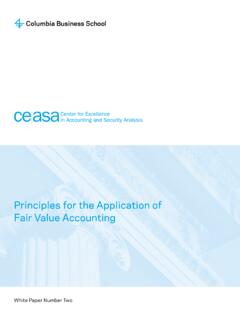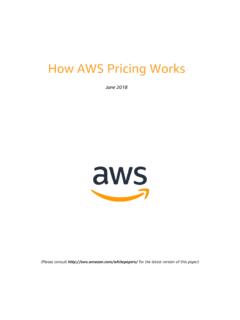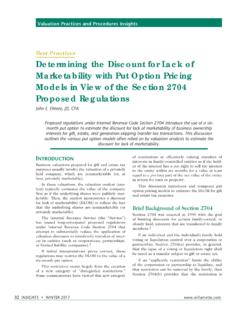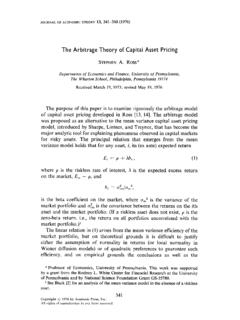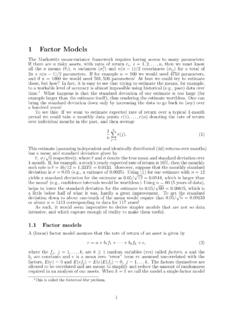Transcription of ARBITRAGE PRICING THEORY
1 ARBITRAGE PRICING THEORY Gur HubermanZhenyu Wang August 15, 2005 AbstractFocusing on asset returns governed by a factor structure, the APT is a one-periodmodel, in which preclusion of ARBITRAGE over static portfolios of these assets leads to alinear relation between the expected return and its covariance with the factors. TheAPT, however, does not preclude ARBITRAGE over dynamic portfolios. Consequently,applying the model to evaluate managed portfolios contradicts the no- ARBITRAGE spiritof the model. An empirical test of the APT entails a procedure to identify featuresof the underlying factor structure rather than merely a collection of mean-varianceefficient factor portfolios that satisfies the linear : ARBITRAGE ; asset PRICING model; factor model. S. N. Durlauf and L. E. Blume,The New Palgrave Dictionary of Economics, forthcoming, PalgraveMacmillan, reproduced with permission of Palgrave Macmillan.
2 This article is taken from the authors original manuscript and has not been reviewed or edited. The definitive published version of this extractmay be found in the completeThe New Palgrave Dictionary of Economicsin print and online, forthcoming. Huberman is at Columbia University. Wang is at the Federal Reserve Bank of New York and theMcCombs School of Business in the University of Texas at Austin. The views stated here are those of theauthors and do not necessarily reflect the views of the Federal Reserve Bank of New York or the FederalReserve ARBITRAGE PRICING THEORY (APT) was developed primarily by Ross (1976a, 1976b).It is a one-period model in which every investor believes that the stochastic propertiesof returns of capital assets are consistent with a factor structure. Ross argues that ifequilibrium prices offer no ARBITRAGE opportunities over static portfolios of the assets,then the expected returns on the assets are approximately linearly related to the factorloadings.
3 (The factor loadings, or betas, are proportional to the returns covarianceswith the factors.) The result is stated in Section (1976a) heuristic argument for the THEORY is based on the preclusion of arbi-trage. This intuition is sketched out in Section 2. Ross formal proof shows that thelinear PRICING relation is a necessary condition for equilibrium in a market where agentsmaximize certain types of utility. The subsequent work, which is surveyed below, de-rives either from the assumption of the preclusion of ARBITRAGE or the equilibrium ofutility-maximization. A linear relation between the expected returns and the betas istantamount to an identification of the stochastic discount factor (SDF). Sections 3 and4, respectively, review this APT is a substitute for the Capital Asset PRICING Model (CAPM) in that bothassert a linear relation between assets expected returns and their covariance withother random variables.
4 (In the CAPM, the covariance is with the market portfolio sreturn.) The covariance is interpreted as a measure of risk that investors cannot avoidby diversification. The slope coefficient in the linear relation between the expectedreturns and the covariance is interpreted as a risk premium. Such a relation is closelytied to mean-variance efficiency, which is reviewed in Section 5 also points out that an empirical test of the APT entails a procedureto identify at least some features of the underlying factor structure. Merely statingthat some collection of portfolios (or even a single portfolio) is mean-variance efficientrelative to the mean-variance frontier spanned by the existing assets does not constitutea test of the APT, because one can always find a mean-variance efficient , as a test of the APT it is not sufficient to merely show that a setof factor portfolios satisfies the linear relation between the expected return and itscovariance with the factors sketch of the empirical approaches to the APT is offered in Section 6, whileSection 7 describes various procedures to identify the underlying factors.
5 The largenumber of factors proposed in the literature and the variety of statistical or ad hocprocedures to find them indicate that a definitive insight on the topic is still , Section 8 surveys the applications of the APT, the most prominent being theevaluation of the performance of money managers who actively change their , the APT does not necessarily preclude ARBITRAGE opportunities overdynamic portfolios of the existing assets. Therefore, the applications of the APT inthe evaluation of managed portfolios contradict at least the spirit of the APT, whichobtains price restrictions by assuming the absence of A Formal StatementThe APT assumes that investors believe that then 1 vector,r, of the single-periodrandom returns on capital assets satisfies the factor modelr= + f+e,(1)whereeis ann 1 vector of random variables,fis ak 1 vector of random variables(factors), is ann 1 vector and is ann kmatrix. With no loss of generality,normalize (1) to makeE[f]=0andE[e] = 0, whereE[ ] denotes expectation and 0denotes the matrix of zeros with the required dimension.
6 The factor model (1) impliesE[r]= .The mathematical proof of the APT requires restrictions on and the covariancematrix =E[ee ]. An additional customary assumption is thatE[e|f] = 0, but thisassumption is not necessary in some of the APT s number of assets,n, is assumed to be much larger than the number of factors,k. In some models,nis infinity or approaches infinity. In this case, representation (1)applies to a sequence of capital markets; the firstnassets in the (n+ 1)st market arethe same as the assets in thenth market and the firstnrows of the matrix in the(n+ 1)st market constitute the matrix in thenth APT asserts the existence of a constantasuch that, for eachn, the inequality( X )Z 1( X ) a(2)holds for a (k+1) 1 vector , and ann npositive definite matrixZ. Here,X=( , ),in which is ann 1 vector of ones. Let 0be the first component of and 1consistsof the rest of the components. If some portfolio of the assets is risk-free, then 0is thereturn on the risk-free portfolio.
7 The positive definite matrixZis often the covariancematrixE[ee ].Exactarbitrage PRICING obtains if (2) is replaced by =X = 0+ 1.(3)The vector 1is referred to as the risk premium, and the matrix is referred to as thebeta or loading on factor interpretation of (2) is that each component of depends approximately lin-early on the corresponding row of . This linear relation is the same across approximation is better, the smaller the constanta;ifa= 0, the linear relation isexact and (3) IntuitionThe intuition behind the model draws from the intuition behind Arrow-Debreu securitypricing. A set ofkfundamental securities spans all possible future states of nature inan Arrow-Debreu model. Each asset s payoff can be described as the payoff on aportfolio of the fundamentalkassets. In other words, an asset s payoff is a weightedaverage of the fundamental assets payoffs. If market clearing prices allow no arbitrageopportunities, then the current price of each asset must equal the weighted average ofthe current prices of the fundamental Arrow-Debreu intuition can be couched in terms of returns and expected re-turns rather than payoffs and prices.
8 If the unexpected part of each asset s returnis a linear combination of the unexpected parts of the returns on thekfundamentalsecurities, then the expected return of each asset is the same linear combination of theexpected returns on thekfundamental see how the Arrow-Debreu intuition leads from the factor structure (1) to exactarbitrage PRICING (3), set the idiosyncratic termeon the right-hand side of (1) equalto zero. Translate thekfactors on the right-hand side of (1) into thekfundamentalsecurities in the Arrow-Debreu model. Then (3) follows presence of the idiosyncratic termein the factor structure (1) makes the modelmore general and realistic. It also makes the relation between (1) and (3) more , no ARBITRAGE arguments typically prove the weaker (2). Moreover, they requirea weaker definition of ARBITRAGE (and therefore a stronger definition of no ARBITRAGE ) inorder to get from (1) to (2).The proofs of (2) augment the Arrow-Debreu intuition with a version of the law oflarge numbers.
9 That law is used to argue that the average effect of the idiosyncraticterms is negligible. In this argument, the independence among the components ofeis used. Indeed, the more one assumes about the (absence of) contemporaneouscorrelations among the component ofe, the tighter the bound on the deviation fromexact No- ARBITRAGE ModelsHuberman (1982) formalizes Ross (1976a) heuristic argument. A portfoliovis ann 1vector. The cost of the portfoliovisv , the income from it isv r, and its return isv r/v (if its cost is not zero). Huberman defines ARBITRAGE as the existence of zero-cost3portfolios such that a subsequence{w}satisfieslimn E[w r]= and limn var[w r]=0,(4)where var[ ] denotes variance. The first requirement in (4) is that the expected incomeassociated withwbecomes large as the number of assets increases. The second re-quirement in (4) is that the risk (as measured by the income s variance) vanishes asthe number of assets increases.
10 Accordingly, a sequence of capital markets offers noarbitrage if there is no subsequence{w}of zero-cost portfolios that satisfy (4).Huberman shows that if the factor model (1) holds and if the covariance matrixE[ee ] is diagonal for allnand uniformly bounded, then the absence of ARBITRAGE implies(2) withZ=Iand a finite bounda. The idea of his proof is as follows. Consider theorthogonal projection of the vector on the linear space spanned by the columns ofX: =X + ,(5)where X= 0 and is ak 1 vector. The projection implies = min ( X ) ( X ).(6)A violation of (2) is the existence of a subsequence of{ }that approaches vector is often referred to as a PRICING error and it can be used to constructarbitrage. For any scalarh, the portfoliow=h has zero cost because the first columnofXis . The factor model (1) and the projection (5) implyE[w r]=h( ) andvar[w r]=h2( E[ee ] ). If 2is the upper bound of the diagonal elements ofE[ee ],then var[w r] h2( ) chosen to be ( ) 2/3, thenE[w r]=( )1/3and var[w r] ( ) 1/3 2, which imply that (4) is satisfied by a subsequence of thezero-cost portfolios{( ) 2/3 }.
